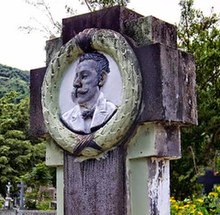| Carlos Ruiz Chapellín | |
|---|---|
 Likeness of Ruiz at his memorial Likeness of Ruiz at his memorial | |
| Born | 1865 Caracas, Venezuela |
| Died | August 1912(1912-08-00) (aged 46–47) |
Carlos Ruiz Chapellín (Caracas, 1865—August 1912) was a Venezuelan showman, filmmaker and performer. He is remembered for creating slapstick comedy films in the late 19th century.
Theatre producer and showman
Ruiz's first business was in putting on popular shows, a pursuit he never gave up through his filmmaking efforts.
Filmmaking
In 1897, shortly after it opened, Ruiz rented the Circo Metropolitano, where he would show zarzuelas and circus variety shows. He also planned to go into the film business after the release of the first Venezuelan films in Maracaibo in January 1897, forming a partnership with Ricardo Rouffet to create their own films. He also hired a man, W. O. Wolcopt from the United States, as part of this venture. Wolcopt brought a Projectoscope [fr] from New York, which was displayed in the Circo from 26 June to 14 July 1897. Ruiz and Wolcopt may have shown a film called Disputa entre Andracistas y Rojistas, which showed a fight between supporters of that year's political candidates Ignacio Andrade and Juan Pablo Rojas Paúl; the nature of the film suggests a Venezuelan author, but there are few records of it. After the show Wolcopt traveled the country for four months with the Projectoscope before returning to Caracas.
Ruiz then hired Gabriel Veyre to show his Cinematograph at the Circo after seeing him project another film at the Fortuna Hall in Caracas. Ruiz and Veyre had a dispute, with Ruiz claiming Veyre was in breach of contract and sent a letter saying so to Veyre's mother; Veyre fled the country to Colombia, but his Cinematograph, which could both record and project film, may have been used to make Ruiz's films. Azuaga García describes Ruiz's choice to hold film showings in a circus as "gaudy", as the previous screenings were held in spectacular theatres and halls, but also suggests it was Ruiz's attempt to "truly bring cinema to the popular classes".
Elisa Martínez de Badra reviews the cinema of early Venezuela shortly by suggesting that the partnership of Ruiz and Wolcopt, along with the first Venezuelan films shown in January 1897, can be considered early examples of attempts at narrative cinema.
He briefly returned to films in 1899, before going back to his production business.
Later life
Ruiz became a devoted writer in his later life. He died in August 1912, and is interred at the Cementerio General del Sur in Caracas.
References
- Rojas Uzcátegui 1986, p. 192.
- ^ Monumental Ciudad de Caracas 2014.
- Rojas Uzcátegui 1986, p. 16.
- ^ Martínez de Badra 2011, p. 67.
- ^ Azuaga García 2015, p. 30.
- Sueiro Villanueva 2007, p. 61-64.
- ^ Serrano 10 November 2014.
- de Miranda 2019.
- FCN 1997, p. 11.
- Azuaga García 2015, p. 29.
- Sueiro Villanueva 2007, p. 69.
- Serrano.
- Azuaga García 2015, p. 37.
Sources
- Literature
- Rojas Uzcátegui, José de la Cruz. (1986). Historia y crítica del teatro venezolano : siglo XIX. Mérida: Universidad de los Andes, Dirección de Cultura, Facultad de Humanidades y Educación, Instituto de Investigaciones Literarias "Gonzalo Picón Febres". ISBN 9802210455. OCLC 17963067.
- Martínez de Badra, Elisa (2011). El guión: fin y transición [The script: end and transition]. Universidad Católica Andres Bello. ISBN 9789802441433.
- Sueiro Villanueva, Yolanda (2007). Inicios de la exhibición cinematográfica en Caracas (1896-1905) [Beginnings of the cinema exhibition in Caracas (1896-1905)] (in Spanish) (1 ed.). Caracas: Fondo Editorial de Humanidades y Educación, Universidad Central de Venezuela. ISBN 978-9800023952. OCLC 225867560.
- Serrano, Arturo. "The Beginnings of Cinema in Venezuela: The arrival of Cinema in Venezuela (1896–1907)". Universidad Católica Andrés Bello. Retrieved 14 December 2018.
{{cite journal}}: Cite journal requires|journal=(help) - Filmografía 1897-1938 [Filmography 1897-1938] (in Spanish). Fundación Cinemateca Nacional. 1997. ISBN 980-074532-7.
- Azuaga García, Jesús Ricardo (September 2015). Pandemonium: La Filmografia de Roman Chalbaud en el Cine Venezolano: Contexto y Analisis [Pandemonium: The Filmography of Roman Chalbaud and the Cinema of Venezuela] (PDF) (Thesis) (in Spanish). Universitat de Valencia.
- Web
- Monumental Ciudad de Caracas (2014). "Cementerio General del Sur en Caracas: Carlos Ruiz Chapellin 1856 - 1912". Flickr.
- Serrano, Arturo (10 November 2014). "Los heroes del cine venezolano (Parte I)" [The heroes of Venezuelan cinema (Part 1)]. Vice Versa (in Spanish). Retrieved 13 September 2019.
- de Miranda, Nancy (2019). "Cronología del Cine Venezolano" [Chronology of Venezuelan Cinema] (in Spanish). Observatorio Cine.
| Cinema of Venezuela | |
|---|---|
| List of Venezuelan films | |
| Decades | |
| Organizations | |
| Festivals | |
| Topics | |